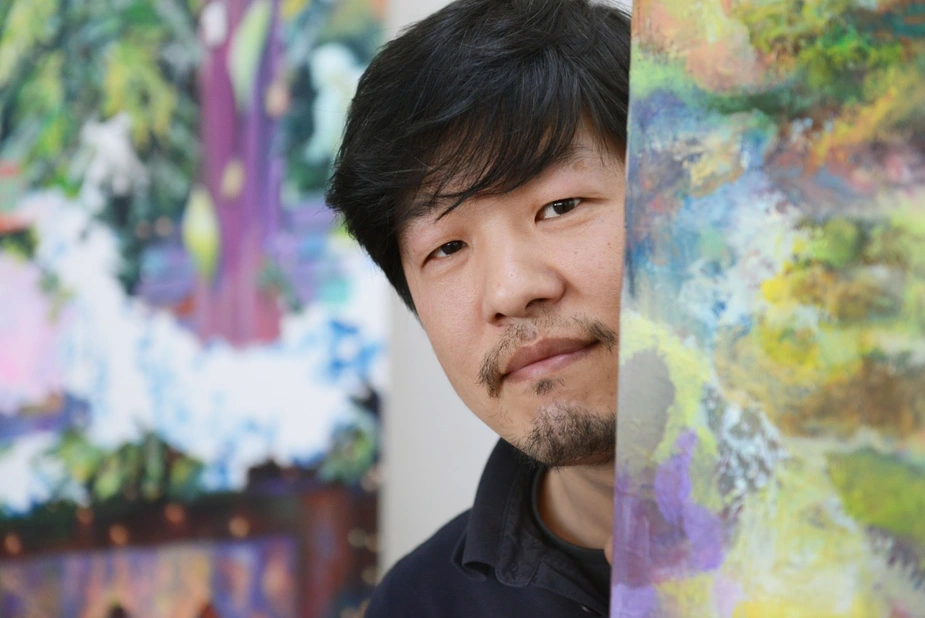Poetry in Colour
The paintings of Korean artist Yongtak Choi are mood boosters.
Since ancient times, scholars and philosophers have been arguing about the concept of poetry and whether painting or poetry is the true way of creating images. According to some, the two art forms are two sides of the same coin. To others, painting is the more limited art form. The writer Gotthold Ephraim Lessing once said that poetry arranges words as extended in time, while painting arranges colours and shapes spatially. To Yongtak Choi, painting is “writing poetry with colours”. And so his last exhibition was rightfully titled “Poetry in Colour”
Yongtak Choi stays with his relatives on his first visit to Germany in December 1999. Back then, not only the weather but the whole atmosphere seemed cold and grey to him. Unlike his home country Korea, where most people prefer colourful clothing, most people here wear dark colours. The people he met, however, changed this perception completely.
Helpful, friendly and open-minded – Choi meets many new people. The painter had already turned 30, had served in the military, and graduated from art school in Seoul. After passing the entrance exam for the Art University Kassel, he studies with the painters Kurt Haug und Jörn Stoya and was admitted to the master class of Urs Lüthi, a Swiss artist whose work includes photography, paintings, performance and video art, and installations. Born in 1973, Choi was struck by the self-confidence of his fellow students, although most of them were much younger than him. They all had a plan and had, as he says, “a mind of their own“. He enjoyed the freedom he had as a student. Looking back on the time in Kassel, it wasn’t about “chasing the dollar”. His work was prolific and free. The shock of a new culture and new environment resulted in high productivity. Unlike his mother, who was always convinced of his talent, Choi took a while to accept this. But he had always been a painter.
Yongtak Choi, whose studio is in Adlershof, often creates faces in his paintings which are embedded into situations like glistening bubbles, independent of time and place. To the critics, the Korean painter works with “the perfection of the old masters” and with “optimism“. They call his paintings “mood boosters“. Choi draws inspiration from Lucian Freud, “the flesh painter”, who does more than paint realistic portraits of his models. Freud penetrates and dissects them. He is also impressed by the magical realism of the Scottish painter Peter Doig, who has a unique way of painting everyday objects with strong colours and abstracts elements, making them seem familiar and curiously strange at the same time. Then there is Miriam Vlaming, the German-Dutch painter of his generation, whose paintings focus on people’s hopes, inclinations, and expectations. She uses strong and marvellously virulent colours to ask us: what makes us alive?
The girl on his picture titled “All + Ein 16” is wearing a pyjama. She looks at the viewer fearfully and timidly. She clutches her cuddly toy as if to protect it. A quick glance and the viewer might see the the wings of an angel which turn out to be the tentacles of a squid. They protect the girl and the valuables she is clinging to. A child in a pyjama evokes images of sleep and dreamscapes. On the one hand, this stands for security, and absolute vulnerability and the need for protection on the other. And so his almost weightless and brightly coloured paintings feel somewhat threatening. All of Yongtak Choi’s paintings develop an intense life of their own and grant the viewer much room for his or her own imagination to wander off and create their own individual poetry. As if immersed under water, these large and often fantastic images of the naked soul try to get to the bottom of the concept of reality.
By Rico Bigelmann for Adlershof Journal
